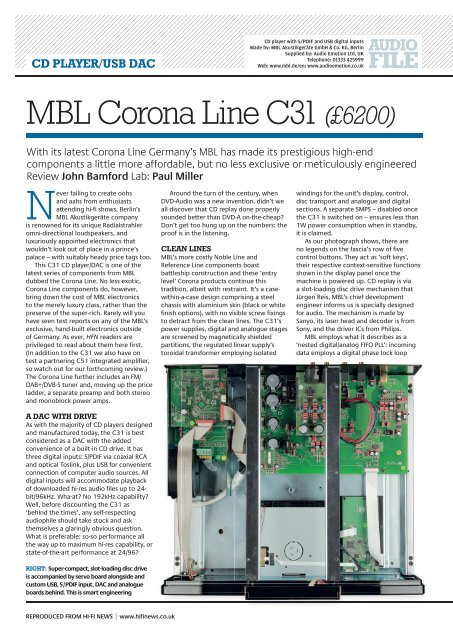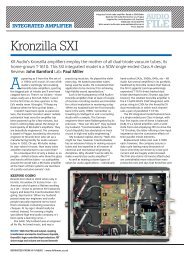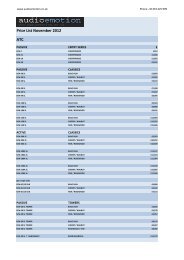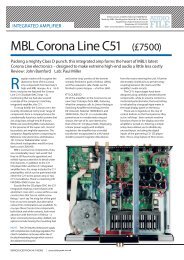MBL Corona C31 CD Player - Audio Emotion
MBL Corona C31 CD Player - Audio Emotion
MBL Corona C31 CD Player - Audio Emotion
You also want an ePaper? Increase the reach of your titles
YUMPU automatically turns print PDFs into web optimized ePapers that Google loves.
<strong>CD</strong> PLAYER/USB DAC<br />
<strong>MBL</strong> <strong>Corona</strong> Line <strong>C31</strong> (£6200)<br />
With its latest <strong>Corona</strong> Line Germany’s <strong>MBL</strong> has made its prestigious high-end<br />
components a little more affordable, but no less exclusive or meticulously engineered<br />
Review John Bamford Lab: Paul Miller<br />
Never failing to create oohs<br />
and aahs from enthusiasts<br />
attending hi-fi shows, Berlin’s<br />
<strong>MBL</strong> Akustikgeräte company<br />
is renowned for its unique Radialstrahler<br />
omni-directional loudspeakers, and<br />
luxuriously appointed electronics that<br />
wouldn’t look out of place in a prince’s<br />
palace – with suitably heady price tags too.<br />
This <strong>C31</strong> <strong>CD</strong> player/DAC is one of the<br />
latest series of components from <strong>MBL</strong><br />
dubbed the <strong>Corona</strong> Line. No less exotic,<br />
<strong>Corona</strong> Line components do, however,<br />
bring down the cost of <strong>MBL</strong> electronics<br />
to the merely luxury class, rather than the<br />
preserve of the super-rich. Rarely will you<br />
have seen test reports on any of the <strong>MBL</strong>’s<br />
exclusive, hand-built electronics outside<br />
of Germany. As ever, HFN readers are<br />
privileged to read about them here fi rst.<br />
(In addition to the <strong>C31</strong> we also have on<br />
test a partnering C51 integrated amplifi er,<br />
so watch out for our forthcoming review.)<br />
The <strong>Corona</strong> Line further includes an FM/<br />
DAB+/DVB-S tuner and, moving up the price<br />
ladder, a separate preamp and both stereo<br />
and monoblock power amps.<br />
A DAC WITH DRIVE<br />
As with the majority of <strong>CD</strong> players designed<br />
and manufactured today, the <strong>C31</strong> is best<br />
considered as a DAC with the added<br />
convenience of a built-in <strong>CD</strong> drive. It has<br />
three digital inputs: S/PDIF via coaxial RCA<br />
and optical Toslink, plus USB for convenient<br />
connection of computer audio sources. All<br />
digital inputs will accommodate playback<br />
of downloaded hi-res audio fi les up to 24bit/96kHz.<br />
Wha-at? No 192kHz capability?<br />
Well, before discounting the <strong>C31</strong> as<br />
‘behind the times’, any self-respecting<br />
audiophile should take stock and ask<br />
themselves a glaringly obvious question.<br />
What is preferable: so-so performance all<br />
the way up to maximum hi-res capability, or<br />
state-of-the-art performance at 24/96?<br />
RIGHT: Super-compact, slot-loading disc drive<br />
is accompanied by servo board alongside and<br />
custom USB, S/PDIF input, DAC and analogue<br />
boards behind. This is smart engineering<br />
REPRODUCED FROM HI-FI NEWS | www.hifi news.co.uk<br />
Around the turn of the century, when<br />
DVD-<strong>Audio</strong> was a new invention, didn’t we<br />
all discover that <strong>CD</strong> replay done properly<br />
sounded better than DVD-A on-the-cheap?<br />
Don’t get too hung up on the numbers: the<br />
proof is in the listening.<br />
CLEAN LINES<br />
<strong>MBL</strong>’s more costly Noble Line and<br />
Reference Line components boast<br />
battleship construction and these ‘entry<br />
level’ <strong>Corona</strong> products continue this<br />
tradition, albeit with restraint. It’s a casewithin-a-case<br />
design comprising a steel<br />
chassis with aluminium skin (black or white<br />
fi nish options), with no visible screw fi xings<br />
to detract from the clean lines. The <strong>C31</strong>’s<br />
power supplies, digital and analogue stages<br />
are screened by magnetically shielded<br />
partitions, the regulated linear supply’s<br />
toroidal transformer employing isolated<br />
<strong>CD</strong> player with S/PDIF and USB digital inputs<br />
Made by: <strong>MBL</strong> Akustikgeräte GmbH & Co. KG, Berlin<br />
Supplied by: <strong>Audio</strong> <strong>Emotion</strong> Ltd, UK<br />
Telephone: 01333 425999<br />
Web: www.mbl.de/en; www.audioemotion.co.uk<br />
windings for the unit’s display, control,<br />
disc transport and analogue and digital<br />
sections. A separate SMPS – disabled once<br />
the <strong>C31</strong> is switched on – ensures less than<br />
1W power consumption when in standby,<br />
it is claimed.<br />
As our photograph shows, there are<br />
no legends on the fascia’s row of fi ve<br />
control buttons. They act as ‘soft keys’,<br />
their respective context-sensitive functions<br />
shown in the display panel once the<br />
machine is powered up. <strong>CD</strong> replay is via<br />
a slot-loading disc drive mechanism that<br />
Jürgen Reis, <strong>MBL</strong>’s chief development<br />
engineer informs us is specially designed<br />
for audio. The mechanism is made by<br />
Sanyo, its laser head and decoder is from<br />
Sony, and the driver ICs from Philips.<br />
<strong>MBL</strong> employs what it describes as a<br />
‘nested digital/analog FIFO PLL’: incoming<br />
data employs a digital phase lock loop
with a high (circa 10kHz) low-pass fi lter<br />
frequency in order to quickly lock to the<br />
signal. The output of the digital PLL goes<br />
into a FIFO buffer and data is rendered via<br />
the output of an analogue PLL with a 1Hz<br />
low-pass fi lter.<br />
The <strong>MBL</strong> insignia logo on the<br />
component’s top plate is encircled by an<br />
illuminated ring – a corona, no less – that<br />
can be pressed to dim the front panel<br />
display in four stages, or switch off entirely.<br />
<strong>Corona</strong> Line components can communicate<br />
with one another via a proprietary<br />
‘SmartLink’ system using Ethernet cables to<br />
ensure common display brightness settings<br />
and provide one-touch operation via the<br />
company’s unifi ed remote control handset.<br />
Use this <strong>C31</strong> with one of its partnering<br />
amplifi ers from the <strong>Corona</strong> Line and the<br />
amplifi er will recognise the <strong>C31</strong>’s digital<br />
inputs, the ‘system’ even intelligently<br />
shutting down the crystal oscillator<br />
governing <strong>CD</strong> playback when, for example,<br />
the USB input is selected – or vice versa.<br />
Only one oscillator is ever active to<br />
avoid potential interference, as well as<br />
minimising power supply demands.<br />
Switch from <strong>CD</strong> playback to a digital<br />
input and after 15 seconds all parts of<br />
the <strong>CD</strong> drive go to sleep. So while the Art<br />
Deco-ish styling might look a little retro,<br />
there’s plenty of carefully-considered,<br />
GERMAN HIGH-END<br />
up-to-date audiophile engineering under<br />
the hood that’s borne out in our Lab Report<br />
[see p23]. Above the rear IEC AC connector,<br />
there’s an integrated SD card reader slot<br />
for uploading any future software updates.<br />
INSTANT APPEAL<br />
It took only a brief audition to identify<br />
the <strong>C31</strong>’s sonic character. Not wholly<br />
dissimilar to the megabucks TAD D300<br />
player/DAC that I had the pleasure of<br />
hearing earlier this year [HFN May ’12], it<br />
sounds extraordinarily ‘analogue’ in nature:<br />
creamy, rich, full-bodied and deliciously<br />
smooth. It sounds airy<br />
and spacious too –<br />
uncommonly so, in fact<br />
– serving up expansive<br />
sonic images with wellproduced<br />
recordings.<br />
It’s a relaxed, confi dent<br />
and luscious sound that I<br />
found instantly appealing.<br />
Patricia Barber’s 1999 album<br />
Companion [Blue Note/Premonition<br />
724352 29632], recorded live in an<br />
intimate jazz club in Chicago with the<br />
audience reverently hushed, showcased<br />
the <strong>C31</strong>’s ability to draw you in to the<br />
mood of a real musical event. Barber’s<br />
warm, breathy voice and creative phrasing<br />
were portrayed wonderfully by the <strong>C31</strong>, its<br />
You need only visit Munich’s High End show to appreciate that audio<br />
manufacturing continues to thrive in Germany, with brands such as Burmester,<br />
T+A and <strong>MBL</strong> – to name only three – creating world-class, cost-no-object<br />
components for audiophiles. Based in Berlin, <strong>MBL</strong> was established in 1979 and<br />
is perhaps best known for its trail-blazing Radialstrahler speakers that inventor<br />
Wolfgang Meletzy and chief designer Jürgen Reis have continued to refi ne over<br />
the years. These omnidirectional speakers employ multiple segment strips of<br />
carbon fi bre that act as bending-mode radiators when a signal is applied to their<br />
voice-coils. The awesome 101 X-treme fl agship Radialstrahlers, incorporating<br />
separate subwoofer towers, cost £172,000. Fancy a complete suite of <strong>MBL</strong>’s<br />
Reference Line electronics to drive them? You’ll be looking at a cool £300k.<br />
‘The <strong>C31</strong> could<br />
draw you in to the<br />
mood of a real<br />
musical event’<br />
ABOVE: <strong>MBL</strong> offers numerous colour ways<br />
for its <strong>Corona</strong> line with black and gold shown<br />
here, white and Palinux (a precious alloy) on our<br />
front cover. The display indicates the (changing)<br />
functions of the fi ve fascia buttons<br />
tonally warm and inviting sound character<br />
full of colour and texture. Image portrayal<br />
was observed to be not particularly deep<br />
but wide and spacious, the musicians<br />
spread openly across the soundstage.<br />
Playing Miles Davis’s Kind Of Blue [Sony/<br />
Columbia 480410 2] found the vintage<br />
jazz masterpiece sounding smooth<br />
and silky, the <strong>C31</strong><br />
comfortably digging<br />
out vital top-end<br />
detail on the lightly<br />
shuffl ing drums and<br />
breaths during sax and<br />
trumpet solos. The<br />
player appeared to<br />
orchestrate the music’s<br />
arrangements and instrumental interplay<br />
beautifully, giving each element of the<br />
recording – such as Paul Chambers’ nimble<br />
double-bass playing – plenty of room to<br />
breathe, even if it lacked some ‘attack’ on<br />
leading edges. This is the only criticism I<br />
can point at the <strong>C31</strong>’s sound: its rendering<br />
of the very lowest frequencies appears a<br />
little bloated and soft.<br />
Indeed, Me’Shell Ndegéocello’s<br />
earth-shaking bass guitar in ‘Mary<br />
Magdalene’ from Peace Beyond Passion<br />
[Maverick 46033] was immensely powerful<br />
and immersive, while the delicate bells and<br />
percussive details in the track still rang out<br />
clearly above the pumping mayhem going<br />
on down below.<br />
The clarity and fi nesse of this player<br />
certainly allows forensic observation of<br />
buried details with ease, all the while the<br />
sound appearing ‘easy’ and comfortable to<br />
listen to during prolonged music sessions.<br />
But I regularly experience tighter bass in<br />
my system, with a fi rmer sense of punch,<br />
www.hifi news.co.uk | REPRODUCED FROM HI-FI NEWS
<strong>CD</strong> PLAYER/USB DAC<br />
ABOVE: There are three 24/96-capable digital inputs: USB and<br />
S/PDIF via RCA and Toslink. Balanced (XLR) and single-ended (RCA) outputs are<br />
provided alongside a coaxial S/PDIF output. Remote controls complete <strong>MBL</strong> system<br />
where this <strong>C31</strong> delivers more of a<br />
swell of creamy bass – full of texture<br />
and detail, but more rolling than<br />
rollicking. More listening only served<br />
to confi rm my initial observation<br />
– that the <strong>C31</strong> delivers a warm,<br />
sensuous sound character that<br />
majors on supreme listenability.<br />
But this doesn’t mean it’s all<br />
syrupy-smooth and soporifi c. Given<br />
the right material it’s an exciting<br />
listen. With up-tempo dance<br />
music and electronica the <strong>C31</strong><br />
delivers a sound that’s effortlessly<br />
entertaining, with a sense of rhythm<br />
and punch that never fails to get you<br />
involved in the music. Bass lines have<br />
immense depth while the player’s<br />
‘widescreen’ image and delightful<br />
sense of air helps create spellbinding<br />
sonic landscapes.<br />
SPACE: REAL OR NOT<br />
I reached for I Syv Sind from the<br />
young Danish music producer<br />
Mike Sheridan [Playground Music<br />
Scandinavia, MIKE<strong>CD</strong>1] in which<br />
sampled sounds – fl oating above a<br />
deep, pumping bass line typical of<br />
the electronica genre – are mixed<br />
with the recorded voice of guest<br />
singer Maya Albana in ‘Med Små<br />
Skridt’ (‘With A Small Step’). The<br />
deep bass sounds had a superb<br />
combination of weight and lowfrequency<br />
extension, the <strong>C31</strong><br />
keeping the myriad sensual threads<br />
comfortably separated.<br />
In a mix like this there’s no real<br />
space – only what the producer/<br />
DJ has decided to create using the<br />
computer tools at his home studio.<br />
Hi-fi components that diminish<br />
the spatial effects created by such<br />
processes, that compress or smear<br />
the soundstage, can’t help but<br />
detract from the musical message.<br />
As it sounds so open and<br />
spacious, the <strong>MBL</strong> did as wonderful<br />
a job with Mike Sheridan’s electronic<br />
production as it did with recordings<br />
where there was a real acoustic<br />
event (like the live jazz performance<br />
of Patricia Barber mentioned<br />
earlier). In this respect, it is the best<br />
<strong>CD</strong> player/DAC I have heard in my<br />
system to date, its confi dent yet<br />
serene character evident whether<br />
playing discs or using its digital<br />
inputs from a computer source.<br />
Of course, the <strong>MBL</strong> <strong>C31</strong> won’t<br />
completely fi x problems in a<br />
recording’s balance and mixing.<br />
For example, harpist Andreas<br />
Vollenweider’s 1989 <strong>CD</strong> release<br />
Dancing With The Lion [Columbia<br />
CK 45154] has always sounded<br />
bright and thin. Individual elements<br />
of the production – drums, piano<br />
and, in particular, the ethereal<br />
backing voices – seemed more<br />
fl eshed out and robust with the <strong>C31</strong>.<br />
So while the Vollenweider<br />
recording’s inadequacies weren’t<br />
completely disguised, the <strong>MBL</strong> <strong>CD</strong><br />
player certainly made the brashness<br />
more bearable. Thanks to its bold,<br />
powerful bass character and smooth<br />
high frequencies, the civilised <strong>C31</strong><br />
never failed to make the most of<br />
the music.<br />
HI-FI NEWS VERDICT<br />
Yes it’s expensive, but in the<br />
realms of high-end audio <strong>MBL</strong>’s<br />
<strong>Corona</strong> <strong>C31</strong> can be considered<br />
a relative bargain given its solid<br />
engineering and outstanding<br />
performance. Sound quality<br />
is sumptuous and beguiling<br />
– simultaneously ballsy and<br />
energetic with airy delicacy and<br />
fi nesse. Any audiophile investing<br />
in a luxurious digital front end<br />
should put the gorgeous <strong>C31</strong> <strong>CD</strong><br />
player/DAC on their shortlist.<br />
Sound Quality: 86%<br />
0 - - - - - - - - 100<br />
LAB<br />
REPORT<br />
<strong>MBL</strong> CORONA LINE <strong>C31</strong> (£6200)<br />
Ordinarily, the discovery that not only <strong>MBL</strong>’s USB but also its<br />
S/PDIF digital inputs are limited to 24-bit/96kHz might have put<br />
a damper on things. But not here, for the <strong>C31</strong>’s performance is<br />
otherwise absolutely exceptional – including with plain vanilla<br />
<strong>CD</strong>. The 4V (balanced) output level, 96ohm source impedance<br />
and 113dB A-wtd S/N ratio are top-notch, as is the vanishingly<br />
low 0.00028% distortion achieved at this level, falling to a<br />
ludicrously low 0.00008% at –10dBFs with 24-bit data over USB<br />
or S/PDIF [red trace, Graph 1 below]. Even at 20kHz distortion<br />
remains just 0.00025% at full output – <strong>MBL</strong>’s supreme analogue<br />
stage fi nally demonstrating the true capabilities of Crystal’s<br />
longstanding CS4398 DAC. THD is fractionally higher via <strong>CD</strong><br />
[black trace, Graph 1] but only because we are dealing with<br />
16-bit data. Low-level resolution is up with the best that even<br />
SA<strong>CD</strong> can offer at ±0.5dB over a full 120dB dynamic range.<br />
Responses are subtly tailored, –0.5dB/20kHz with<br />
44.1kHz/48kHz inputs and –3.6dB/45kHz with 24-bit/96kHz<br />
over USB or S/PDIF. Moreover, even with default USB 1.0 PC<br />
drivers, the USB input’s performance mirrors 24-bit S/PDIF with<br />
state-of-the-art distortion fi gures, a 113dB A-wtd S/N ratio and<br />
jitter right on the baseline at 10-15psec. Rarely have we seen<br />
such a close parity between USB and S/PDIF with default drivers<br />
[see Graph 2, below and p35]. A >100dB channel separation,<br />
any idle patterns





